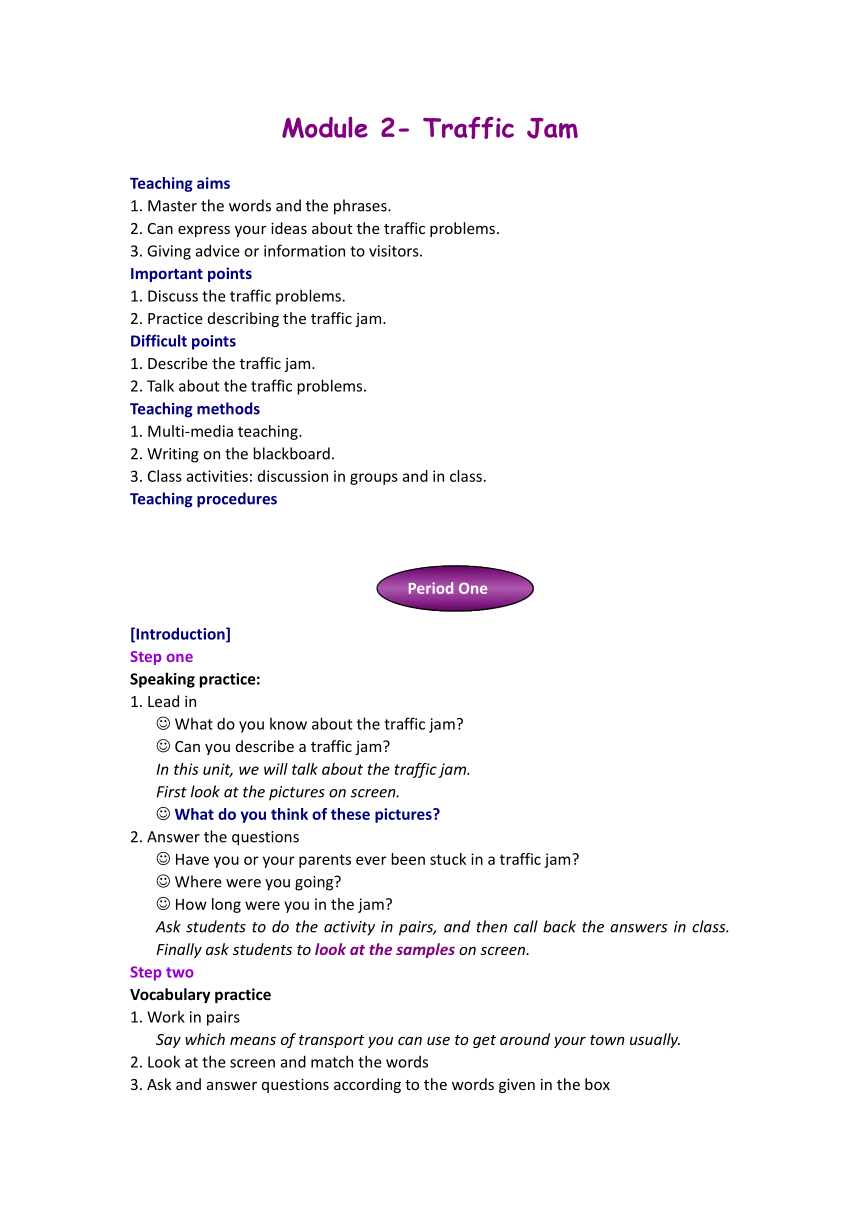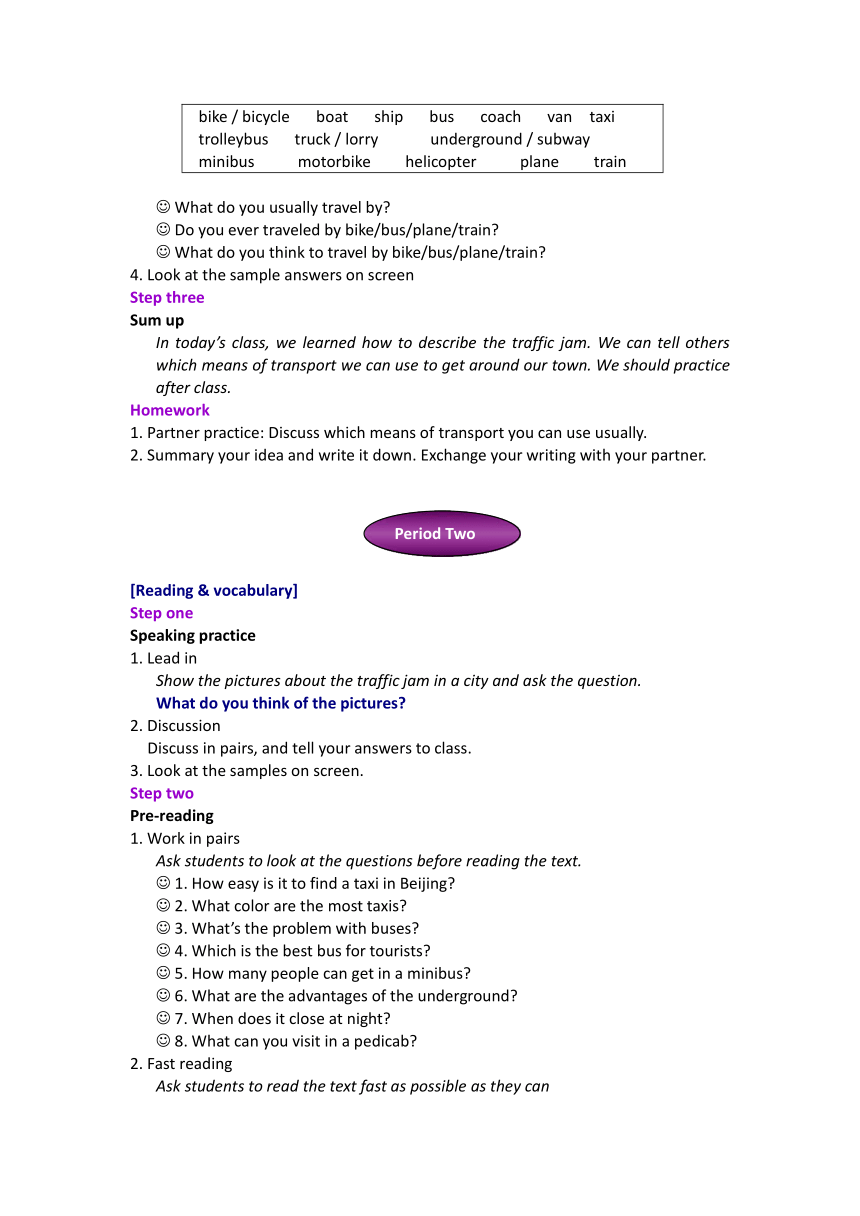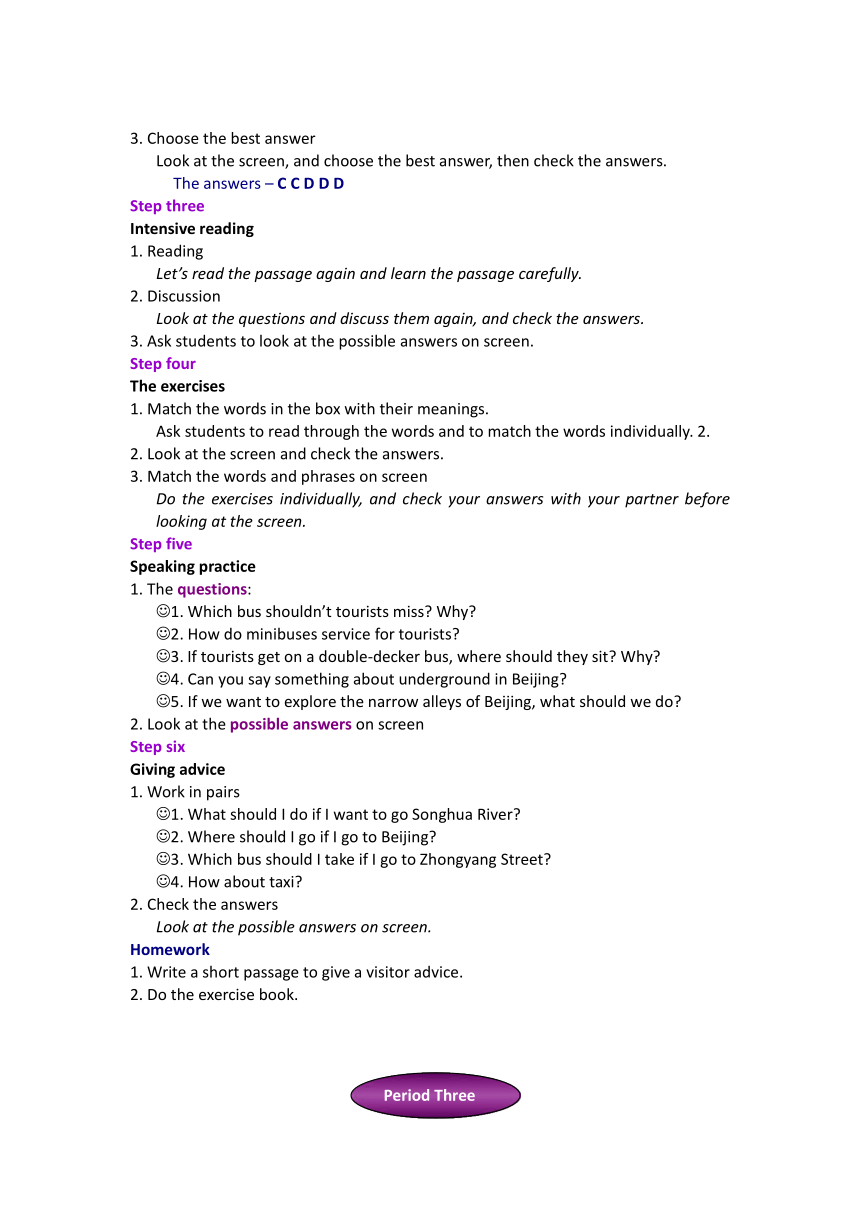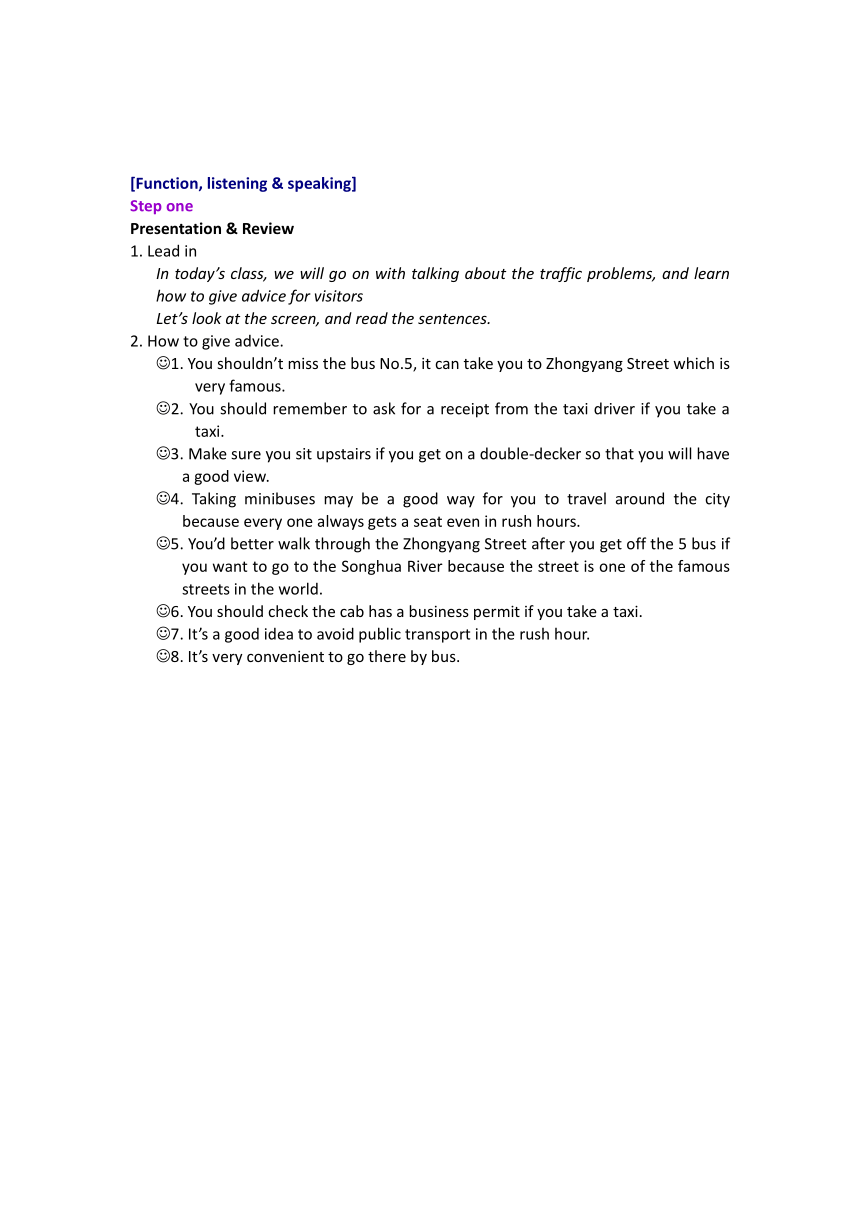外研版高一英语必修四Module 2 Traffic Jam 全单元教案
文档属性
| 名称 | 外研版高一英语必修四Module 2 Traffic Jam 全单元教案 |  | |
| 格式 | zip | ||
| 文件大小 | 19.1KB | ||
| 资源类型 | 教案 | ||
| 版本资源 | 外研版 | ||
| 科目 | 英语 | ||
| 更新时间 | 2019-10-16 22:29:25 | ||
图片预览




文档简介
Module 2- Traffic Jam
Teaching aims
1. Master the words and the phrases.
2. Can express your ideas about the traffic problems.
3. Giving advice or information to visitors.
Important points
1. Discuss the traffic problems.
2. Practice describing the traffic jam.
Difficult points
1. Describe the traffic jam.
2. Talk about the traffic problems.
Teaching methods
1. Multi-media teaching.
2. Writing on the blackboard.
3. Class activities: discussion in groups and in class.
Teaching procedures
[Introduction]
Step one
Speaking practice:
1. Lead in
? What do you know about the traffic jam?
? Can you describe a traffic jam?
In this unit, we will talk about the traffic jam.
First look at the pictures on screen.
? What do you think of these pictures?
2. Answer the questions
? Have you or your parents ever been stuck in a traffic jam?
? Where were you going?
? How long were you in the jam?
Ask students to do the activity in pairs, and then call back the answers in class. Finally ask students to look at the samples on screen.
Step two
Vocabulary practice
1. Work in pairs
Say which means of transport you can use to get around your town usually.
2. Look at the screen and match the words
3. Ask and answer questions according to the words given in the box
bike / bicycle boat ship bus coach van taxi
trolleybus truck / lorry underground / subway
minibus motorbike helicopter plane train
? What do you usually travel by?
? Do you ever traveled by bike/bus/plane/train?
? What do you think to travel by bike/bus/plane/train?
4. Look at the sample answers on screen
Step three
Sum up
In today’s class, we learned how to describe the traffic jam. We can tell others which means of transport we can use to get around our town. We should practice after class.
Homework
1. Partner practice: Discuss which means of transport you can use usually.
2. Summary your idea and write it down. Exchange your writing with your partner.
[Reading & vocabulary]
Step one
Speaking practice
1. Lead in
Show the pictures about the traffic jam in a city and ask the question.
What do you think of the pictures?
2. Discussion
Discuss in pairs, and tell your answers to class.
3. Look at the samples on screen.
Step two
Pre-reading
1. Work in pairs
Ask students to look at the questions before reading the text.
? 1. How easy is it to find a taxi in Beijing?
? 2. What color are the most taxis?
? 3. What’s the problem with buses?
? 4. Which is the best bus for tourists?
? 5. How many people can get in a minibus?
? 6. What are the advantages of the underground?
? 7. When does it close at night?
? 8. What can you visit in a pedicab?
2. Fast reading
Ask students to read the text fast as possible as they can
3. Choose the best answer
Look at the screen, and choose the best answer, then check the answers.
The answers – C C D D D
Step three
Intensive reading
1. Reading
Let’s read the passage again and learn the passage carefully.
2. Discussion
Look at the questions and discuss them again, and check the answers.
3. Ask students to look at the possible answers on screen.
Step four
The exercises
1. Match the words in the box with their meanings.
Ask students to read through the words and to match the words individually. 2.
2. Look at the screen and check the answers.
3. Match the words and phrases on screen
Do the exercises individually, and check your answers with your partner before looking at the screen.
Step five
Speaking practice
1. The questions:
?1. Which bus shouldn’t tourists miss? Why?
?2. How do minibuses service for tourists?
?3. If tourists get on a double-decker bus, where should they sit? Why?
?4. Can you say something about underground in Beijing?
?5. If we want to explore the narrow alleys of Beijing, what should we do?
2. Look at the possible answers on screen
Step six
Giving advice
1. Work in pairs
?1. What should I do if I want to go Songhua River?
?2. Where should I go if I go to Beijing?
?3. Which bus should I take if I go to Zhongyang Street?
?4. How about taxi?
2. Check the answers
Look at the possible answers on screen.
Homework
1. Write a short passage to give a visitor advice.
2. Do the exercise book.
[Function, listening & speaking]
Step one
Presentation & Review
1. Lead in
In today’s class, we will go on with talking about the traffic problems, and learn how to give advice for visitors
Let’s look at the screen, and read the sentences.
2. How to give advice.
?1. You shouldn’t miss the bus No.5, it can take you to Zhongyang Street which is very famous.
?2. You should remember to ask for a receipt from the taxi driver if you take a taxi.
?3. Make sure you sit upstairs if you get on a double-decker so that you will have a good view.
?4. Taking minibuses may be a good way for you to travel around the city because every one always gets a seat even in rush hours.
?5. You’d better walk through the Zhongyang Street after you get off the 5 bus if you want to go to the Songhua River because the street is one of the famous streets in the world.
?6. You should check the cab has a business permit if you take a taxi.
?7. It’s a good idea to avoid public transport in the rush hour.
?8. It’s very convenient to go there by bus.
Step two
Listening & speaking
1. Read and guess
Read the sentences on the text book before you listen to the tape, and tick the topic you think they will talk about.
2. Work in pairs
Exchange your tickings with your partner, and say why you choose the one or ones.
Step three
Listening
1. Listening
Pay attention to the questions while you are listening.
?1. Who were in front of the speaker 1 when he got stuck in the traffic? What did they do?
?2. What did the speaker 2 do a few weeks ago? Why did he say that was just ridiculous?
?3. According to the speaker 3, who caused the traffic jam? How did they do?
?4. How does the Beijing traffic recently? Why?
?5. Where did the speaker 5 go the other evening? What happened at a narrow bridge?
2. Work in pairs
Listen to the listening material again and discuss the questions.
Step four
Listening and speaking
1. Listening
Listen to the tape again and match the traffic situations (Ex. 2)
2. Check the answers on screen.
1.b 2.c 3.c 4.a 5.c
3. Speaking
Listen to it again and answer the questions given on screen at first.
4. Check the answers on screen.
Step five
Exercise
1. The exercise 4 on page 15
Listen to it again and answer the questions.
2. Check the answers on screen
Step six
Vocabulary
1. Match the words from Box A with Box B to make compound nouns.
2. Match the words and definitions
Work in pairs and check the answers with your partner.
3. Check the answers of Ex. 1 and Ex. 2 on screen.
Step seven
Pronunciation
1. Listening
2. Speaking
Homework
1. Discuss with your partner to talk about the traffic jam.
2. Write down what you talked about with your partner.
[Grammar, pronunciation & writing]
Step one
Grammar
1. Lead in
Today we will review imperative
Look at these sentences about dos or don’ts on page 17.
All of the statements are imperatives. Pay attention to the usage of the verbs.
( Do … / Don’t … )
2. The exercise 1 on page 16
Look at the signs on page 16 and say what they do.
3. Check the answer on screen
Step two
Speaking practice
1. Speaking
Look at the signs and say what the signs mean and check the answers on screen.
2. The exercise 3 on page 17
Do the exercise individually first and then discuss with your partner.
3. Check the answers on screen.
Step three
Speaking
1. The exercises
Do the exercises 1 and 2 individually first and then check the answer on screen.
2. Work in groups
Put the students into four groups to talk about the traffic problems and suggestions. One of the students in every group should come up with a list.
3. Class activity
Ask students to read their list of the problems. And call back the problems and suggestions from the whole class.
Step four
Writing practice
1. Read the passage carefully and find the way to write a better passage.
* 1. The writer divided the passage into two parts. The first part is about problems, and the second part is about the solutions.
* 2. Put forward the problems first, and give some advice to solve the problems.
2. Read the passage again and answer the question.
Let’s check the answers on screen.
3. Write a similar passage about your town
Look at the sample writing on the screen please.
Step five
Everyday English
1. Do the exercises individually and then check with your partner.
2. Check the answers on screen.
Homework
1. Review what we’ve learned in the unit.
2. Do the exercise book.
[Cultural corner]
Step one
Leading in
1. Reading and thinking
Read the questions. Then look at the pictures and think over.
?1. Do you know about the cities?
?2. Is Beijing the only city with traffic problems?
?3. Does the traffic problem occur only in developing countries?
?4. What about the developed countries?
?5. What’s your opinion about these questions?
2. Pre-reading
Look at the questions before read the text.
Discuss the questions in pairs while you are reading,
?1. What is a congestions charge?
?2. Is Beijing the only city with traffic problems?
?3. Where does the worst problem occur?
?4. Can you give some names of the cities where the worst problems occur except the cities the passage mentioned?
?5. Which city is now the USA’s most congested city?
?6. What did the Mayor of London introduce according to the passage?
?7. How can they solve the problems according to the passage?
?8. Did Londoners agree with the idea to pay the charge for cars coming into city centre? Why?
?9. Were the cars coming into central London reduced? What did more people use to get to work?
?10. Who think the charge should be increased? Why?
Step two
Fast reading
1. Choose the best answer
Look at the screen and choose the best answer after you finish the fast reading.
2. Check the answers on screen.
Step three
Intensive reading
1. Discussion
Look at the questions and discuss them again, and check the answers.
2. Ask students to look at the possible answers on screen.
Step four
Task
1. Speaking
Work in pairs to give advice or information to visitors.
2. Look at possible answers on screen.
Step five
Module file
1. Reading
Read and remember what we’ve learned.
2. Practice
Look at the screen and read.
Step six
Summary
In this unit, we learned how to give advice, and how to talk about the traffic.
When we give advice, we should use --
1. The samples:
Why not …
Why don’t you?
Make sure you …
You should …
You’d better …
It’s a good idea to …
2. Look at the samples on screen
Homework
1. Talking about the traffic in your town, and giving advice to visitors about the public traffic.
2. Finish the exercise of this unit.
Teaching aims
1. Master the words and the phrases.
2. Can express your ideas about the traffic problems.
3. Giving advice or information to visitors.
Important points
1. Discuss the traffic problems.
2. Practice describing the traffic jam.
Difficult points
1. Describe the traffic jam.
2. Talk about the traffic problems.
Teaching methods
1. Multi-media teaching.
2. Writing on the blackboard.
3. Class activities: discussion in groups and in class.
Teaching procedures
[Introduction]
Step one
Speaking practice:
1. Lead in
? What do you know about the traffic jam?
? Can you describe a traffic jam?
In this unit, we will talk about the traffic jam.
First look at the pictures on screen.
? What do you think of these pictures?
2. Answer the questions
? Have you or your parents ever been stuck in a traffic jam?
? Where were you going?
? How long were you in the jam?
Ask students to do the activity in pairs, and then call back the answers in class. Finally ask students to look at the samples on screen.
Step two
Vocabulary practice
1. Work in pairs
Say which means of transport you can use to get around your town usually.
2. Look at the screen and match the words
3. Ask and answer questions according to the words given in the box
bike / bicycle boat ship bus coach van taxi
trolleybus truck / lorry underground / subway
minibus motorbike helicopter plane train
? What do you usually travel by?
? Do you ever traveled by bike/bus/plane/train?
? What do you think to travel by bike/bus/plane/train?
4. Look at the sample answers on screen
Step three
Sum up
In today’s class, we learned how to describe the traffic jam. We can tell others which means of transport we can use to get around our town. We should practice after class.
Homework
1. Partner practice: Discuss which means of transport you can use usually.
2. Summary your idea and write it down. Exchange your writing with your partner.
[Reading & vocabulary]
Step one
Speaking practice
1. Lead in
Show the pictures about the traffic jam in a city and ask the question.
What do you think of the pictures?
2. Discussion
Discuss in pairs, and tell your answers to class.
3. Look at the samples on screen.
Step two
Pre-reading
1. Work in pairs
Ask students to look at the questions before reading the text.
? 1. How easy is it to find a taxi in Beijing?
? 2. What color are the most taxis?
? 3. What’s the problem with buses?
? 4. Which is the best bus for tourists?
? 5. How many people can get in a minibus?
? 6. What are the advantages of the underground?
? 7. When does it close at night?
? 8. What can you visit in a pedicab?
2. Fast reading
Ask students to read the text fast as possible as they can
3. Choose the best answer
Look at the screen, and choose the best answer, then check the answers.
The answers – C C D D D
Step three
Intensive reading
1. Reading
Let’s read the passage again and learn the passage carefully.
2. Discussion
Look at the questions and discuss them again, and check the answers.
3. Ask students to look at the possible answers on screen.
Step four
The exercises
1. Match the words in the box with their meanings.
Ask students to read through the words and to match the words individually. 2.
2. Look at the screen and check the answers.
3. Match the words and phrases on screen
Do the exercises individually, and check your answers with your partner before looking at the screen.
Step five
Speaking practice
1. The questions:
?1. Which bus shouldn’t tourists miss? Why?
?2. How do minibuses service for tourists?
?3. If tourists get on a double-decker bus, where should they sit? Why?
?4. Can you say something about underground in Beijing?
?5. If we want to explore the narrow alleys of Beijing, what should we do?
2. Look at the possible answers on screen
Step six
Giving advice
1. Work in pairs
?1. What should I do if I want to go Songhua River?
?2. Where should I go if I go to Beijing?
?3. Which bus should I take if I go to Zhongyang Street?
?4. How about taxi?
2. Check the answers
Look at the possible answers on screen.
Homework
1. Write a short passage to give a visitor advice.
2. Do the exercise book.
[Function, listening & speaking]
Step one
Presentation & Review
1. Lead in
In today’s class, we will go on with talking about the traffic problems, and learn how to give advice for visitors
Let’s look at the screen, and read the sentences.
2. How to give advice.
?1. You shouldn’t miss the bus No.5, it can take you to Zhongyang Street which is very famous.
?2. You should remember to ask for a receipt from the taxi driver if you take a taxi.
?3. Make sure you sit upstairs if you get on a double-decker so that you will have a good view.
?4. Taking minibuses may be a good way for you to travel around the city because every one always gets a seat even in rush hours.
?5. You’d better walk through the Zhongyang Street after you get off the 5 bus if you want to go to the Songhua River because the street is one of the famous streets in the world.
?6. You should check the cab has a business permit if you take a taxi.
?7. It’s a good idea to avoid public transport in the rush hour.
?8. It’s very convenient to go there by bus.
Step two
Listening & speaking
1. Read and guess
Read the sentences on the text book before you listen to the tape, and tick the topic you think they will talk about.
2. Work in pairs
Exchange your tickings with your partner, and say why you choose the one or ones.
Step three
Listening
1. Listening
Pay attention to the questions while you are listening.
?1. Who were in front of the speaker 1 when he got stuck in the traffic? What did they do?
?2. What did the speaker 2 do a few weeks ago? Why did he say that was just ridiculous?
?3. According to the speaker 3, who caused the traffic jam? How did they do?
?4. How does the Beijing traffic recently? Why?
?5. Where did the speaker 5 go the other evening? What happened at a narrow bridge?
2. Work in pairs
Listen to the listening material again and discuss the questions.
Step four
Listening and speaking
1. Listening
Listen to the tape again and match the traffic situations (Ex. 2)
2. Check the answers on screen.
1.b 2.c 3.c 4.a 5.c
3. Speaking
Listen to it again and answer the questions given on screen at first.
4. Check the answers on screen.
Step five
Exercise
1. The exercise 4 on page 15
Listen to it again and answer the questions.
2. Check the answers on screen
Step six
Vocabulary
1. Match the words from Box A with Box B to make compound nouns.
2. Match the words and definitions
Work in pairs and check the answers with your partner.
3. Check the answers of Ex. 1 and Ex. 2 on screen.
Step seven
Pronunciation
1. Listening
2. Speaking
Homework
1. Discuss with your partner to talk about the traffic jam.
2. Write down what you talked about with your partner.
[Grammar, pronunciation & writing]
Step one
Grammar
1. Lead in
Today we will review imperative
Look at these sentences about dos or don’ts on page 17.
All of the statements are imperatives. Pay attention to the usage of the verbs.
( Do … / Don’t … )
2. The exercise 1 on page 16
Look at the signs on page 16 and say what they do.
3. Check the answer on screen
Step two
Speaking practice
1. Speaking
Look at the signs and say what the signs mean and check the answers on screen.
2. The exercise 3 on page 17
Do the exercise individually first and then discuss with your partner.
3. Check the answers on screen.
Step three
Speaking
1. The exercises
Do the exercises 1 and 2 individually first and then check the answer on screen.
2. Work in groups
Put the students into four groups to talk about the traffic problems and suggestions. One of the students in every group should come up with a list.
3. Class activity
Ask students to read their list of the problems. And call back the problems and suggestions from the whole class.
Step four
Writing practice
1. Read the passage carefully and find the way to write a better passage.
* 1. The writer divided the passage into two parts. The first part is about problems, and the second part is about the solutions.
* 2. Put forward the problems first, and give some advice to solve the problems.
2. Read the passage again and answer the question.
Let’s check the answers on screen.
3. Write a similar passage about your town
Look at the sample writing on the screen please.
Step five
Everyday English
1. Do the exercises individually and then check with your partner.
2. Check the answers on screen.
Homework
1. Review what we’ve learned in the unit.
2. Do the exercise book.
[Cultural corner]
Step one
Leading in
1. Reading and thinking
Read the questions. Then look at the pictures and think over.
?1. Do you know about the cities?
?2. Is Beijing the only city with traffic problems?
?3. Does the traffic problem occur only in developing countries?
?4. What about the developed countries?
?5. What’s your opinion about these questions?
2. Pre-reading
Look at the questions before read the text.
Discuss the questions in pairs while you are reading,
?1. What is a congestions charge?
?2. Is Beijing the only city with traffic problems?
?3. Where does the worst problem occur?
?4. Can you give some names of the cities where the worst problems occur except the cities the passage mentioned?
?5. Which city is now the USA’s most congested city?
?6. What did the Mayor of London introduce according to the passage?
?7. How can they solve the problems according to the passage?
?8. Did Londoners agree with the idea to pay the charge for cars coming into city centre? Why?
?9. Were the cars coming into central London reduced? What did more people use to get to work?
?10. Who think the charge should be increased? Why?
Step two
Fast reading
1. Choose the best answer
Look at the screen and choose the best answer after you finish the fast reading.
2. Check the answers on screen.
Step three
Intensive reading
1. Discussion
Look at the questions and discuss them again, and check the answers.
2. Ask students to look at the possible answers on screen.
Step four
Task
1. Speaking
Work in pairs to give advice or information to visitors.
2. Look at possible answers on screen.
Step five
Module file
1. Reading
Read and remember what we’ve learned.
2. Practice
Look at the screen and read.
Step six
Summary
In this unit, we learned how to give advice, and how to talk about the traffic.
When we give advice, we should use --
1. The samples:
Why not …
Why don’t you?
Make sure you …
You should …
You’d better …
It’s a good idea to …
2. Look at the samples on screen
Homework
1. Talking about the traffic in your town, and giving advice to visitors about the public traffic.
2. Finish the exercise of this unit.
